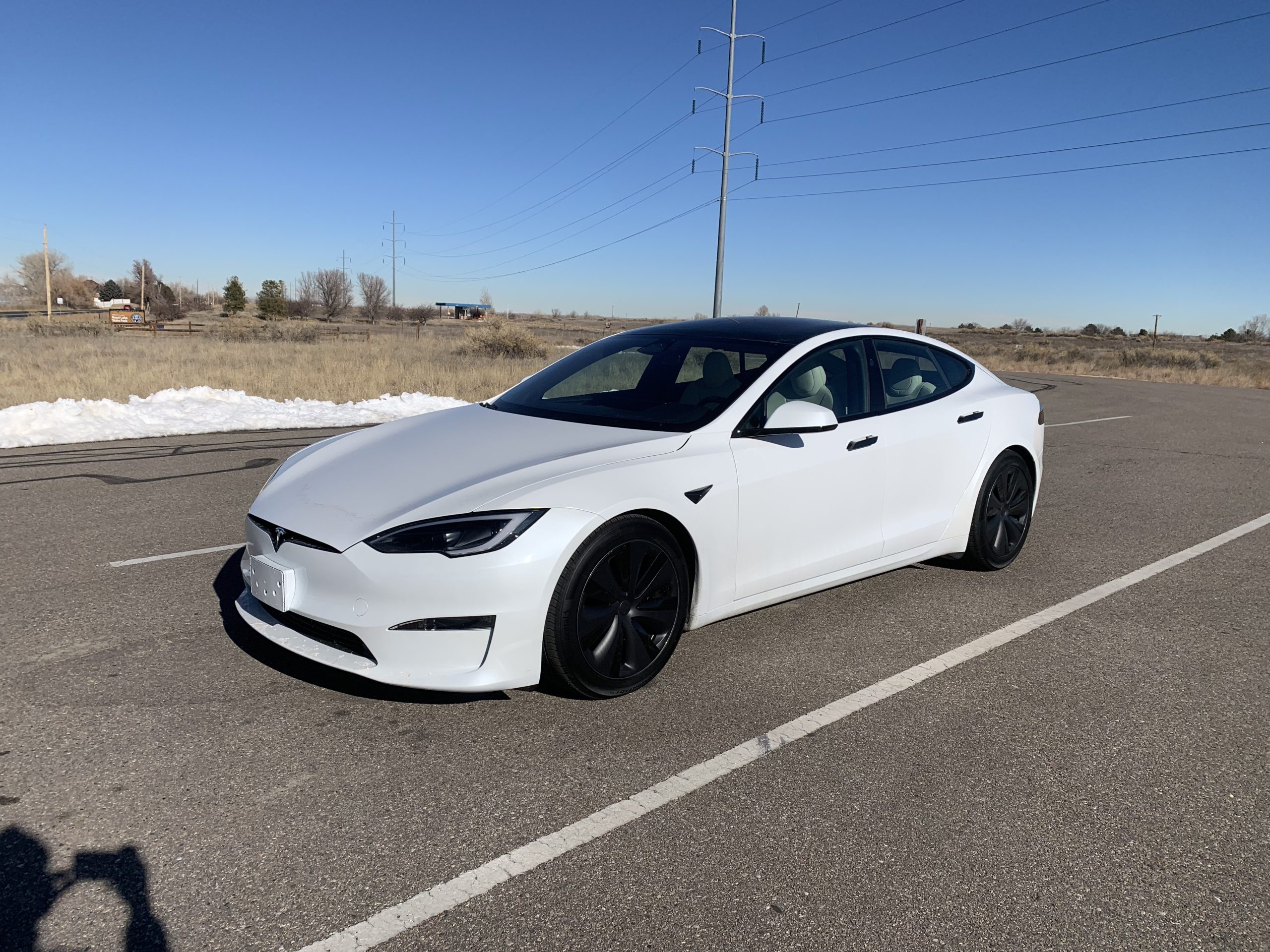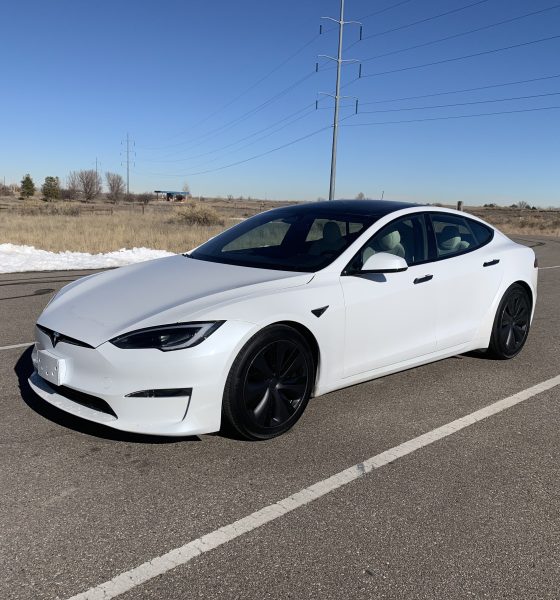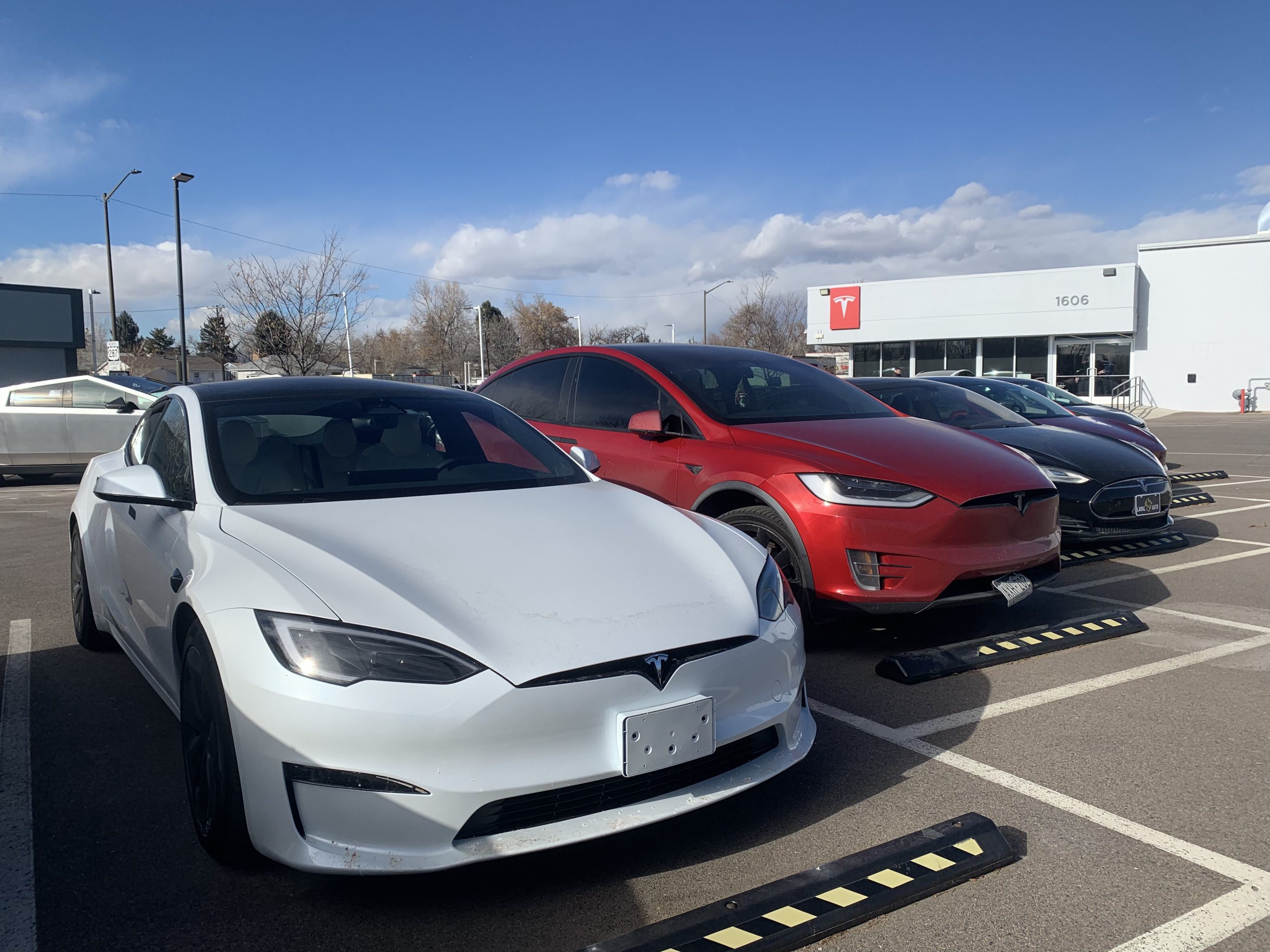

News
I tried Tesla’s FSD Supervised on a demo drive—Here’s what I learned
Tesla’s Supervised Full Self-Driving (FSD) has been at the center of the company’s long-term strategy for years, and seeing as I’ve been covering the company and its competitors since 2020, I decided it was finally time to try it out myself.
The process of scheduling a demo drive was simple: I scheduled it online through Tesla’s test drive page, and because I was hoping to focus on FSD, I shot an email over to the Loveland team letting them know that I was coming and was planning to try the software out. I got a quick response, in which one of the advisors offered to schedule me for an extended demo drive, effectively giving me a three-hour window to try out FSD Supervised.
On Monday, I headed out from my house in Fort Collins, Colorado, to the next town over, Loveland, to try Tesla’s latest FSD Supervised version available. While I initially scheduled a demo drive for a Model Y with FSD Supervised v13.2.2, one of the Tesla advisors informed me that there was also a Model S on-site with version v13.2.2.1, so I elected to test that one instead.
After getting a quick rundown from the advisor on the Model S, my demo drive officially began. I typed my first destination into the navigation system, pressed and held the blue “Start FSD (Supervised)” button, and off I went.


Tesla’s FSD Supervised: autonomy is definitely on the way
Perhaps many people have this experience when trying FSD out for the first time, but right off the bat, I found myself laughing at how it worked and a little scared that it would make a mistake. This Model S was now driving me out of the Loveland Tesla parking lot to a nearby Target, through busy parking lots, turns and lane changes, and it was pretty uncomfortable at first not to be the one making the maneuvers—let alone the fact that no person was making these maneuvers, but rather it was the vehicle doing it on its own.
I felt like an anxious passenger—my feet pressed firmly on the floor in distrust and disbelief—only I was sitting in the driver’s seat. I really couldn’t do much but laugh at how strange the experience had felt so far.
Then, not long after my first trip, something interesting happened.
My mindset slowly shifted from fear to trust with each correct maneuver, and I managed my first few drives without disengaging at all, offering a true testament to how well FSD Supervised performed on this test. Granted, I went in without too much of a plan and wasn’t targeting fringe cases or particularly tough maneuvers; I just wanted to see if this car could drive me around for a few hours, and to feel what it was like to demo FSD Supervised as a newcomer.
It’s worth noting that I did most of my driving in FSD’s Chill mode, though I also tested a few drives in both Standard and Hurry. Personally, I think I would probably keep it in Chill mode most of the time, as it’s the most similar to how I drive of the three.
Below are a few moments from the drive that show some of the system’s capabilities, even turning onto busy roads that would be difficult for a human driver.

Tesla’s FSD Supervised reverses out of a parking spot… and we’re off
A simple reverse out of a parking spot, a good start! pic.twitter.com/TIx2yDmSxT
— TESLARATI (@Teslarati) January 15, 2025
Tesla’s FSD Supervised takes a few left turns onto busy roads
Another busy left turn – “FSD handled this busy turn with ease.” pic.twitter.com/SncR0Kh7ar
— TESLARATI (@Teslarati) January 15, 2025
Another left turn during a somewhat busy time of day – “I was a little scared, not going to lie, but FSD handled it well.” pic.twitter.com/WNunR05C3h
— TESLARATI (@Teslarati) January 15, 2025
Tesla’s FSD Supervised tackles a two-lane roundabout and parking lot
Roundabout? No problem! – “A two-lane roundabout that FSD handled pretty comfortably.” pic.twitter.com/X9QJIVXb6z
— TESLARATI (@Teslarati) January 15, 2025
Left-hand turn out of a parking lot – “It was pretty busy in there but it was well handled, the car navigated easily through the intersection just as I would have.” pic.twitter.com/Kzxb0aYtFN
— TESLARATI (@Teslarati) January 15, 2025
READ MORE ON TESLA’S FSD SUPERVISED: Tesla Cybertruck receives FSD (Supervised) v13.2.4 update
The temptation not to pay attention, and my most critical disengagement
Elon Musk and others have talked up FSD Supervised v13 since its release, as well as claiming that unsupervised driving is just around the corner. While it does feel closer than ever after years of reporting on small tweaks, improvements and developments, I think it’s also worth emphasizing again that the system still requires the driver to pay attention, even though it’s tempting to believe that it can handle all the driving by itself.
As I drove more and more, or rather as the car drove me, I became more comfortable trusting that FSD Supervised was going to make the right decisions, which it did about 99 percent of the time. I was lulled into somewhat of a false sense of safety that almost had me believing the vehicle didn’t need to be supervised, but that 1 percent of the time (maybe even less) that it did get confused still required my input.
I only had a few interventions for the whole experience, but one in particular had me a little scared after having become a little complacent and too trusting. As you can see in the video below, FSD Supervised was looking to merge into the right lane, when two vehicles slowed down. The Model S attempted to change lanes anyway, requiring me to overtake the wheel and keep driving straight.
Our first bit of adversity – “This was the most dangerous intervention I faced (I only had about three the whole time). FSD was trying to merge right, but the vehicles in that lane slowed down, and the car didn’t seem to understand what was going on. It started merging into the… pic.twitter.com/hJUBnCAjd2
— TESLARATI (@Teslarati) January 15, 2025
Besides the quick moment of fear in deciding I needed to take the wheel, it really was not a big deal once I regained control. It was actually a good wake-up call: this system still needs to be supervised, even if it makes fewer and fewer mistakes with each new version and feels like a solid human driver for the vast majority of the time.
I had a few other disengagements on my drive, mostly when the vehicle seemed to get confused about uncommon traffic circumstances or in confusing parking lot scenarios without clear signage. However, these moments made up a very small portion of my experience, and I can only imagine what another couple of years of development will do.
Tesla’s FSD Supervised: still needs supervision, but I got a good glimpse into a future of autonomy
All in all, I really enjoyed trying out FSD Supervised and I hope to do it again sometime. Additionally, I’d recommend trying it out to anyone, especially if you’re interested in seeing where driving tech is headed.
While I definitely got a glimpse into the future potential for fully autonomous driving, I also think it still requires supervision, even if just for those very seldom moments where the system gets confused. The margin for error with driving safety is obviously extremely low, though I do believe Tesla will eventually make good on its aim to make this system better than human drivers in time—and it already feels pretty close the majority of the time.
I hope to do this again sometime soon, and a major shout out to the Tesla Loveland team for making the experience smooth and for answering all my questions along the way.
What are your thoughts? Let me know at zach@teslarati.com, find me on X at @zacharyvisconti, or send us tips at tips@teslarati.com.
Tesla employees are performing autonomous FSD trials, CEO Elon Musk says
Need accessories for your Tesla? Check out the Teslarati Marketplace:

News
Tesla Diner defies the ‘Doom’ narrative: Profitable, Popular, and Here to Stay

The Tesla Diner has been subject to many points of criticism since its launch in mid-2025, and skeptics and disbelievers claim the company’s latest novel concept is on its way down, but there’s a lot of evidence to state that is not the case.
The piece cites anecdotal evidence like empty parking lots, more staff than customers during a December visit, removed novelty items, like Optimus robot popcorn service and certain menu items, the departure of celebrity chef Eric Greenspan in November 2025, slow service, high prices, and a shift in recent Google/Yelp reviews toward disappointment.
The piece frames this as part of broader Tesla struggles, including sales figures and Elon Musk’s polarizing image, calling it a failed branding exercise rather than a sustainable restaurant.
This narrative is overstated and sensationalized, and is a good representation of coverage on Tesla by today’s media.
Novelty Fade is Normal, Not Failure
Any hyped launch, especially a unique Tesla-branded destination blending dining, Supercharging, and a drive-in theater, naturally sees initial crowds taper off after the “Instagram effect” wears down.
Tesla makes major change at Supercharger Diner amid epic demand
This is common for experiential spots in Los Angeles, especially pop-up attractions or celebrity-backed venues. The article admits early success with massive lines and social media buzz, but treats the return to normal operations as “dying down.”
In reality, this stabilization is a healthy sign of transitioning from hype-driven traffic to steady patronage.
Actual Performance Metrics Contradict “Ghost Town” Claims
- In Q4 2025, the Diner generated over $1 million in revenue, exceeding the average McDonald’s location
- It sold over 30,000 burgers and 83,000 fries in that quarter alone. These figures indicate a strong ongoing business, especially for a single-location prototype focused on enhancing Supercharger experiences rather than competing as a mass-market chain
It’s not a ghost town lol. The @Tesla Diner still had over 30,000 burger orders and 83,000 fries orders in Q4. The diner generated over $1M in revenue in Q4, a $4M annual run rate, which is more than the average McDonald’s…. pic.twitter.com/XvAGLUqxej
— Sawyer Merritt (@SawyerMerritt) January 4, 2026
Conflicting On-the-Ground Reports
While the article, and other similar pieces, describe a half-full parking lot and sparse customers during specific off-peak visits, other recent accounts push back:
- A January 2026 X post noted 50 of 80 Supercharger stalls were busy at 11 a.m., calling it “the busiest diner in Hollywood by close to an order of magnitude
TESLA DINER 🍔
Frantic!!!
Crazy busy. pic.twitter.com/wMbmr8SFFn
— Rich & Sharon (@HullTeslaModel3) January 4, 2026
- Reddit discussions around the same time describe it as not empty when locals drive by regularly, with some calling the empty narrative “disingenuous anti-Tesla slop.”
When we visited it last week it was packed. We had to wait to enter, get a table and go to the restroom. We were lucky to find a spot to charge.
— Rani G (@ranig) January 4, 2026
Bottom Line
The Tesla Diner, admittedly, is not the nonstop circus it was at launch–that was never sustainable or intended. But, it’s far from “dying” or an “empty pit stop.”
It functions as a successful prototype: boosting Supercharger usage, generating solid revenue, and serving as a branded amenity in the high-traffic EV market of Los Angeles.
News
Tesla stands to win big from potential adjustment to autonomous vehicle limitations
Enabling scale, innovation, and profitability in a sector that is growing quickly would benefit Tesla significantly, especially as it has established itself as a leader.

Tesla stands to be a big winner from a potential easing of limitations on autonomous vehicle development, as the United States government could back off from the restrictions placed on companies developing self-driving car programs.
The U.S. House Energy and Commerce subcommittee will hold a hearing later this month that will aim to accelerate the deployment of autonomous vehicles. There are several key proposals that could impact the development of self-driving cars and potentially accelerate the deployment of this technology across the country.
These key proposals include raising the NHTSA’s exemption cap from 2,500 to 90,000 vehicles per year per automaker, preempting state-level regulations on autonomous vehicle systems, and mandating NHTSA guidelines for calibrating advanced driver assistance systems (ADAS).
Congress, to this point, has been divided on AV rules, with past bills like the 2017 House-passed measure stalling in the Senate. Recent pushes come from automakers urging the Trump administration to act faster amid competition from Chinese companies.
Companies like Tesla, who launched a Robotaxi service in Austin and the Bay Area last year, and Alphabet’s Waymo are highlighted as potential beneficiaries from lighter sanctions on AV development.
The NHTSA recently pledged to adopt a quicker exemption review for autonomous vehicle companies, and supporters of self-driving tech argue this will boost U.S. innovation, while critics are concerned about safety and job risks.
How Tesla Could Benefit from the Proposed Legislation
Tesla, under CEO Elon Musk’s leadership, has positioned itself as a pioneer in autonomous driving technology with its Full Self-Driving software and ambitious Robotaxi plans, including the Cybercab, which was unveiled in late 2024.
The draft legislation under consideration by the U.S. House subcommittee could provide Tesla with significant advantages, potentially transforming its operational and financial landscape.
NHTSA Exemption Cap Increase
First, the proposed increase in the NHTSA exemption cap from 2,500 to 90,000 vehicles annually would allow Tesla to scale up development dramatically.
Currently, regulatory hurdles limit how many fully autonomous vehicles can hit the roads without exhaustive approvals. For Tesla, this means accelerating the rollout of its robotaxi fleet, which Musk envisions as a network of millions of vehicles generating recurring revenue through ride-hailing. With Tesla’s vast existing fleet of over 6 million vehicles equipped with FSD hardware, a higher cap could enable rapid conversion and deployment, turning parked cars into profit centers overnight.
Preempting State Regulations
A united Federal framework would be created if it could preempt State regulations, eliminating the patchwork of rules that currently complicate interstate operations. Tesla has faced scrutiny and restrictions in states like California, especially as it has faced harsh criticism through imposed testing limits.
A federal override of State-level rules would reduce legal battles, compliance costs, and delays, allowing Tesla to expand services nationwide more seamlessly.
This is crucial for Tesla’s growth strategy, as it operates in multiple markets and aims for a coast-to-coast Robotaxi network, competing directly with Waymo’s city-specific expansions.
Bringing Safety Standards to the Present Day
Innovation in the passenger transportation sector has continued to outpace both State and Federal-level legislation, which has caused a lag in the development of many things, most notably, self-driving technology.
Updating these outdated safety standards, especially waiving requirements for steering wheels or mirrors, directly benefits Tesla’s innovative designs. Tesla wanted to ship Cybertruck without side mirrors, but Federal regulations required the company to equip the pickup with them.
Cybercab is also planned to be released without a steering wheel or pedals, and is tailored for full autonomy, but current rules would mandate human-ready features.
Streamlined NHTSA reviews would further expedite approvals, addressing Tesla’s complaints about bureaucratic slowdowns. In a letter written in June to the Trump Administration, automakers, including Tesla, urged faster action, and this legislation could deliver it.
In Summary
This legislation represents a potential regulatory tailwind for Tesla, but it still relies on the government to put forth action to make things easier from a regulatory perspective. Enabling scale, innovation, and profitability in a sector that is growing quickly would benefit Tesla significantly, especially as it has established itself as a leader.
News
Nvidia CEO Jensen Huang explains difference between Tesla FSD and Alpamayo
“Tesla’s FSD stack is completely world-class,” the Nvidia CEO said.

NVIDIA CEO Jensen Huang has offered high praise for Tesla’s Full Self-Driving (FSD) system during a Q&A at CES 2026, calling it “world-class” and “state-of-the-art” in design, training, and performance.
More importantly, he also shared some insights about the key differences between FSD and Nvidia’s recently announced Alpamayo system.
Jensen Huang’s praise for Tesla FSD
Nvidia made headlines at CES following its announcement of Alpamayo, which uses artificial intelligence to accelerate the development of autonomous driving solutions. Due to its focus on AI, many started speculating that Alpamayo would be a direct rival to FSD. This was somewhat addressed by Elon Musk, who predicted that “they will find that it’s easy to get to 99% and then super hard to solve the long tail of the distribution.”
During his Q&A, Nvidia CEO Jensen Huang was asked about the difference between FSD and Alpamayo. His response was extensive:
“Tesla’s FSD stack is completely world-class. They’ve been working on it for quite some time. It’s world-class not only in the number of miles it’s accumulated, but in the way it’s designed, the way they do training, data collection, curation, synthetic data generation, and all of their simulation technologies.
“Of course, the latest generation is end-to-end Full Self-Driving—meaning it’s one large model trained end to end. And so… Elon’s AD system is, in every way, 100% state-of-the-art. I’m really quite impressed by the technology. I have it, and I drive it in our house, and it works incredibly well,” the Nvidia CEO said.
Nvidia’s platform approach vs Tesla’s integration
Huang also stated that Nvidia’s Alpamayo system was built around a fundamentally different philosophy from Tesla’s. Rather than developing self-driving cars itself, Nvidia supplies the full autonomous technology stack for other companies to use.
“Nvidia doesn’t build self-driving cars. We build the full stack so others can,” Huang said, explaining that Nvidia provides separate systems for training, simulation, and in-vehicle computing, all supported by shared software.
He added that customers can adopt as much or as little of the platform as they need, noting that Nvidia works across the industry, including with Tesla on training systems and companies like Waymo, XPeng, and Nuro on vehicle computing.
“So our system is really quite pervasive because we’re a technology platform provider. That’s the primary difference. There’s no question in our mind that, of the billion cars on the road today, in another 10 years’ time, hundreds of millions of them will have great autonomous capability. This is likely one of the largest, fastest-growing technology industries over the next decade.”
He also emphasized Nvidia’s open approach, saying the company open-sources its models and helps partners train their own systems. “We’re not a self-driving car company. We’re enabling the autonomous industry,” Huang said.








